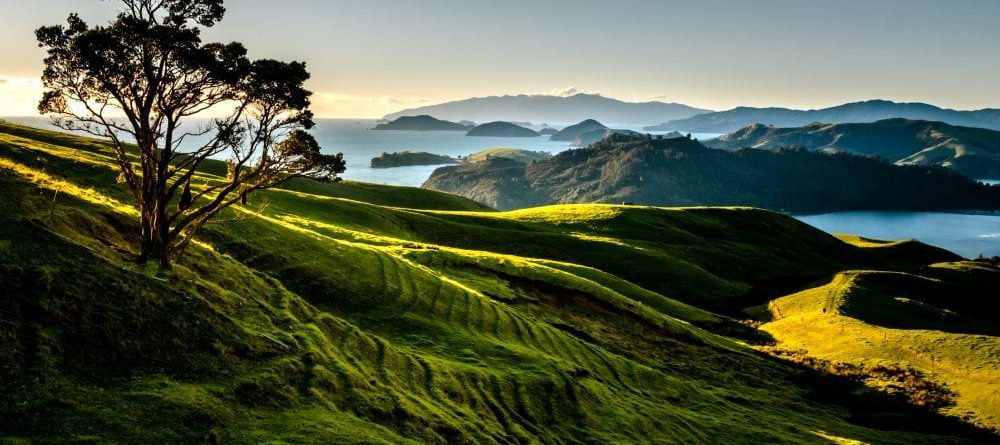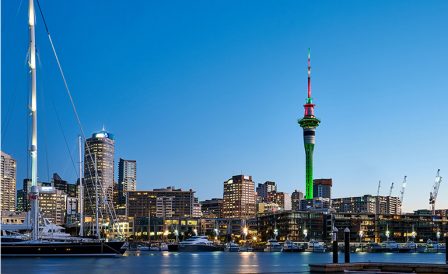The nature of New Zealand is mesmerizing and breathtaking. It has amazingly clear air and remarkably green grass. According to a legend, before God created the Earth, he first tried it out on a small piece of land. And the result was amazing and exceeded all the expectations.

That’s how New Zealand appeared.
New Zealand is one of the few places in the world with a wide variety of natural landscapes and climate zones within a relatively small area—just 268,000 km².
It has everything: vast marine and ocean expanses with endless sandy beaches, cliffs, and rocky shores. High mountains capped with snow and glaciers. Fields, forests, plains, hills, and evergreen meadows. Crystal-clear lakes and rivers that reflect the sky on their smooth surface. You can even find tropical rainforests and landscapes that resemble Antarctica.
Every year, tens of thousands of tourists visit the country to experience these unique places. New Zealand is one of the world’s most popular destinations for ecotourism, and the government actively supports and promotes this sector.
‘Keep 100% pure New Zealand’ is a motto of New Zealand’s government.
Animals
Like other regions with a temperate climate, New Zealand has less diversity in plant and animal species than tropical countries. However, the country’s isolation has created unique conditions for the development of its flora and fauna, leading to the evolution of species found nowhere else in the world.
For example, of the 2,500 species of conifers, flowering plants, and ferns growing in New Zealand, more than 80% are endemic—they do not exist anywhere else on Earth. Of the 245 bird species that bred in New Zealand before human arrival, 71% were endemic. This high percentage is mainly due to the country’s remote location, far from other landmasses.
Before humans arrived, there were no land mammals on the islands, except for two species of bats. Marine mammals like whales swam in coastal waters, and fur seals and sea lions basked on the shores. When humans settled in New Zealand, animals—both intentionally and accidentally—were introduced. First came rats and dogs, followed later by Europeans who brought cats, rabbits, possums, wallabies, ferrets, sheep, pigs, cows, deer, and even moose. These mammals—especially predators—along with human hunting and land use, caused severe damage to the islands’ unique biodiversity.
One striking example of this is the extinction of the giant flightless Moa, which stood up to 3.5 meters tall. It is believed that the Moa were hunted to extinction by the Māori people around the 1500s. Following the Moa’s extinction, the Haast’s eagle—the largest eagle known to humanity—also died out, having lost its primary food source. These massive birds had wingspans of up to 3 meters and weighed around 15 kilograms.
Another species under threat is the iconic flightless bird Kiwi. Its main enemies are introduced predators and rodents, as well as habitat loss due to deforestation.

Over the few hundred years of human settlement in New Zealand, 58 bird species have gone extinct—more than a quarter of the country’s total bird population.
To prevent further loss of unique life forms, the government has introduced a wide range of wildlife protection measures. These include the removal of non-native animal species brought by humans, which have since spread across the country, as well as the establishment of numerous protected areas. In total, around 30% of New Zealand’s land is under protection. This includes 16 national parks—three of which are marine parks—along with hundreds of reserves and other zones with special visitation rules.
New Zealand is also home to two UNESCO World Heritage Sites: the Tongariro National Park on the North Island and Te Wahipounamu on the South Island. Both reserves are incredibly beautiful and unique, and hold deep cultural significance. Te Wahipounamu is especially notable because flora and fauna from the ancient supercontinent Gondwana—of which New Zealand was once a part—have been discovered there. This discovery was a key reason for Te Wahipounamu’s inclusion in the UNESCO World Heritage list.
Volcanos
New Zealand is truly a land of volcanoes. Within the area of the country’s largest city, Auckland, there are 48 relatively small volcanoes spread across just 20 square kilometers. Some are barely noticeable, while others have retained a clear cone shape and are easily visible in the landscape. Climbing them offers stunning views of the city and coastline. These 48 volcanoes stretch from Lake Pupuke in the north to Mount McLachlan in the south, forming what is known as the Auckland Volcanic Field.
Rangitoto
The largest and also the youngest volcano in New Zealand is Rangitoto Island. Its eruption occurred only about 600 years ago, witnessed by the Māori who were already living on the islands at the time. The volcano has preserved its symmetrical, well-defined cone-shaped summit. Rising to 260 meters, it is located just 11 kilometers off the Auckland coastline, making it easily visible from many of the city’s eastern beaches. Rangitoto has become one of Auckland’s most iconic landmarks and is accessible by regular ferry service. Every year, it is visited by hundreds of thousands of tourists and locals alike.
Maungawhau

Another volcano, Maungawhau — also known as Mount Eden — is the second highest volcano in the Auckland Volcanic Field. Standing at 196 meters tall, it is the highest natural point within the city limits. Located very close to Auckland’s central business district, it has become a popular lookout point for tourists who come to enjoy panoramic city views, while locals often visit to watch the sunset or admire fireworks displays.
Tongariro
In the central part of the North Island rises the unique volcanic massif of Tongariro. It is situated within the country’s oldest national park, also called Tongariro, which is listed as a UNESCO World Heritage site. The reserve features ancient Māori structures, beautiful waterfalls, and numerous rare species of flora and fauna. The massif is made up of 12 volcanic peaks. The highest of them is Mount Ruapehu, reaching 2,797 meters, while the youngest and most active is Mount Ngauruhoe. Although only partially open to visitors, the mountain range is a favorite destination for hikers. The famous Tongariro Alpine Crossing — one of the most renowned day hikes in the world — runs through the valley between the volcanoes.
The volcanoes of the Tongariro massif are so majestic and dramatic that director Peter Jackson chose them as the filming location for Mount Orodruin (Mount Doom) in The Lord of the Rings trilogy, where the One Ring was forged and eventually destroyed. Mount Ngauruhoe portrayed Mount Doom in the film. However, because Ngauruhoe holds special spiritual and cultural significance for the Māori people, climbing its summit is restricted. As a result, some scenes had to be filmed on another volcano in the massif — Mount Ruapehu.
White island
Another volcano in New Zealand that deserves special attention is White Island. Like the Tongariro Volcanic Massif, it is part of the larger Taupo Volcanic Zone. Located 48 kilometers off the eastern coast of New Zealand’s North Island, it was, until recently, considered one of the most accessible “active” volcanoes in the world. The volcano has been in an active state for over forty years and attracted thousands of tourists eager to witness the raw power of our planet up close.
Until recently, the crater was open to visitors, but after the eruption in December 2019 — which tragically claimed the lives of twenty-two tourists — access to the island was suspended.
Fiords
Breathtaking in its beauty and pristine wilderness, Fiordland National Park is another one of New Zealand’s truly “magical” places.
Fiordland is the largest national park in the country, covering an area of over 12,500 km². It is located in the southwest of the South Island, within the Te Wahipounamu reserve, which, like Tongariro National Park, is a UNESCO World Heritage Site. Fiordland National Park is home to 15 fiords, the most famous of which are the stunningly beautiful Milford Sound, the deepest black-water fiord Doubtful Sound, and the largest — Dusky Sound — stretching up to 40 kilometers in length and 8 kilometers in width.
Fiordland National Park is one more UNESCO World Heritage site in New Zealand.
The fiords here were formed over 100,000 years ago through glacial activity. As the climate warmed, the glaciers melted, revealing long, narrow valleys with steep and jagged cliffs, which were then filled with seawater. One of the most famous hiking trails in New Zealand — and in the world — the Milford Track, is located in this region.

Cascading waterfalls dropping from heights of hundreds of meters, ancient tropical forests, magical shimmering lakes, and towering mountain peaks are all in their pristine state. And they form one of the most breathtaking natural wonders, best experienced through hiking. It is here that you’ll find perhaps the most famous trail in New Zealand and one of the most iconic in the world — the Milford Track.
Starting from the small and cozy town of Te Anau, the trail stretches over 53 kilometers, winding through some of the most awe-inspiring landscapes. Mountains, lakes, and vast valleys are allover the way to Sutherland Falls. It is the tallest waterfall in New Zealand. Rudyard Kipling described it as the “Eighth Wonder of the World”. Milford Sound leaves no one untouched.
Rivers and lakes
In New Zealand, you’re never far from water. Wherever you go, you’ll be accompanied by coastal landscapes, shimmering lake surfaces, gentle rivers, and waterfalls cascading down mountains.

Among all of these, the lakes are especially captivating. Formed primarily by two natural forces — volcanic activity on the North Island and glaciers on the South Island — they are scattered across the country in great numbers. There are over 3,000 lakes in total, including 270 with an area larger than 500 square meters.
The largest of them is Lake Taupō. It is in the central part of the North Island. This is no ordinary lake: it was formed in the caldera of a supervolcano, whose eruption was the most powerful on Earth in the past 5,000 years. The site is unique not only for its origin but also for the scenic shoreline with its dramatic rock formations. Another fascinating feature is the floating stones that don’t sink — something that surprises many tourists at first. Upon closer inspection, the stones turn out to be porous volcanic glass, also known as pumice.
The neighboring alpine lakes Pukaki and Tekapo are among the most photographed lakes in New Zealand. They are located on the South Island within the Te Wāhipounamu protected area. These lakes have gained worldwide fame thanks to the unusually striking color of their waters. Lake Tekapo is famous for its mesmerizing bright turquoise-blue hue, while Lake Pukaki displays a milky-turquoise tone. The water gets its unique color from “glacial flour” — fine silt carried into the lakes by rivers that originate in the Southern Alps.



